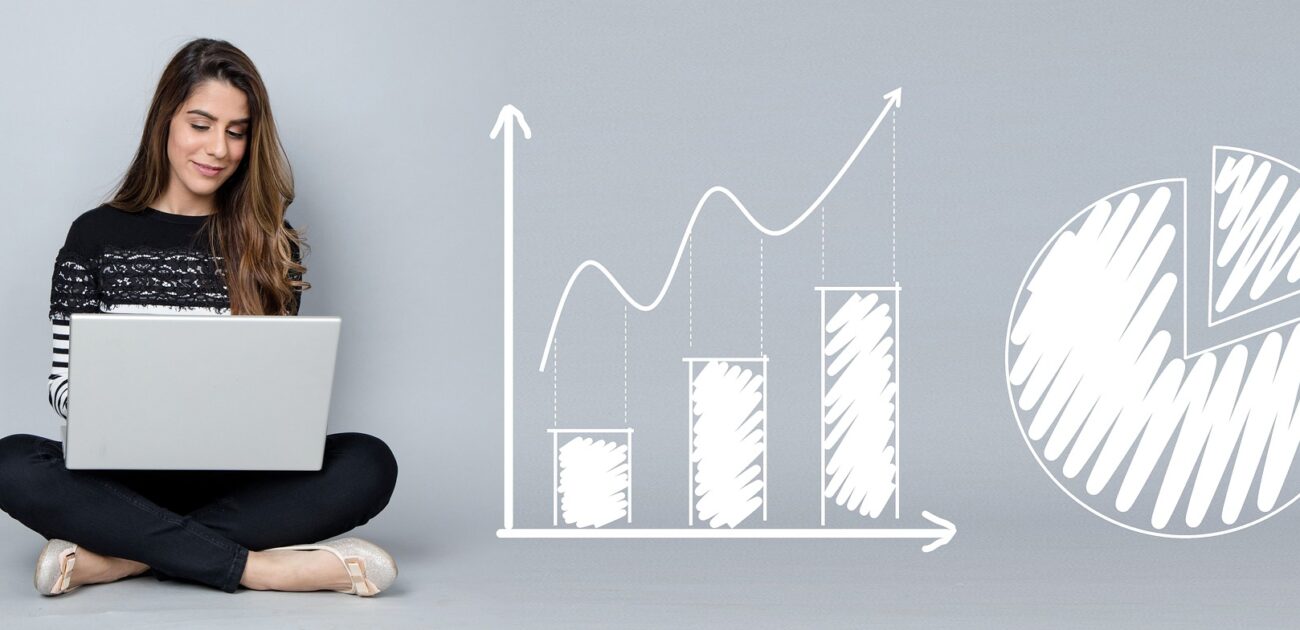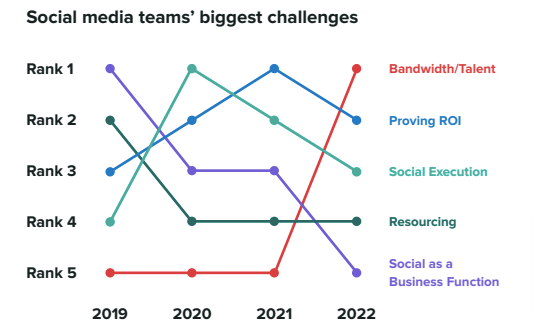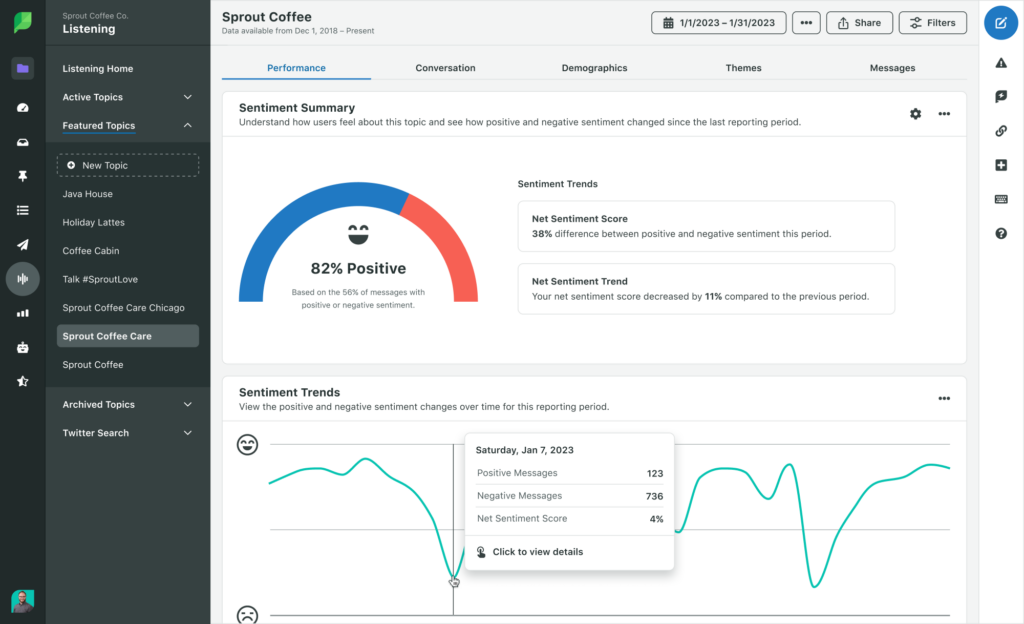As marketers, we have more data at our fingertips than ever before. Yet research from Sprout Social reveals that proving ROI is consistently one of the biggest challenges for social media teams.
Demonstrating the impact of your actions is all about monitoring the right metrics for social media marketing — metrics that speak directly to your overarching business goals.
To help you choose those metrics, we’ve rounded up 13 of the most impactful social media metrics to track.
Metrics for Measuring Social Media Awareness
Tracking social media metrics related to brand awareness helps you understand how many people see your content — and how this impacts your audience size. Key awareness metrics include:
1. Total Reach
Let’s start with a simple (but important) one: reach is a social media metric showing the number of individual accounts that have seen a post.
There’s no way to monitor this metric yourself unless you fancy asking every single social media user if they caught your latest meme. But it’s built into pretty much every social media management tool and some social media platforms.
2. Total Impressions
Impressions demonstrate how many times people see your content, measured at the account level or across individual posts.
We know what you’re thinking: “Isn’t that just the same as reach?”
Not quite. While reach and impressions are similar metrics, impressions count the total number of times a post has been viewed, whereas reach only counts unique views. In other words, if you look at an individual post three times, you’ve racked up three impressions, but you only count as one person reached.
When a post has a particularly skewed ratio of impressions to reach, this indicates people are checking it out multiple times, so it’s worth trying to figure out what keeps them coming back.
3. Audience Size
On the face of things, audience size feels like a meaningless vanity metric — especially in a world where thousands of followers can be bought for a few dollars.
In reality, it’s important to keep track of over time because it adds useful context to other metrics. For instance, if you see a sudden spike in your engagement rate (more on that later), it could be because you’ve lost followers.
Which probably isn’t a good thing.
4. Follower Growth Rate
This metric goes hand in hand with audience size. Because it doesn’t just matter how many followers you have — it’s also important to track whether that number is tracking up or down (and how fast it’s changing).
Use the following formula to calculate your follower growth rate:
(Followers gained or lost in a specific period / Number of followers you had at the start of that period) x 100
Let’s plug in some numbers to demonstrate how that looks. Say you started Q1 with 15,000 followers, and by the end of the quarter, that number had grown to 18,000 (an increase of 3,000). Dividing 3,000 by 15,000 gives you a figure of 0.2 or a follower growth rate of 20%.
Metrics for Measuring Social Media Engagement
While awareness is about the number of people who’ll potentially see your content, engagement metrics focus on what happens when a post appears in someone’s feed. You should measure these engagement metrics:
5. Engagement Rate
Starting with the basics, engagement rate is a social media metric measuring the percentage of your audience sharing, commenting on, and reacting to your content.
The word “audience” is a nebulous term: it could refer to your total follower count, the number of people who see a post, or the total size of your potential audience on a given platform.
However, the most common way to measure engagement rate is to use the following formula:
(Total likes, comments, and shares / Total followers) x 100
6. Amplification Rate
Amplification rate is similar to engagement rate, except it looks specifically at the proportion of your audience that shares your content. The higher the rate, the more frequently your followers are amplifying your posts to their networks.
Calculate the amplification rate as follows:
(Total post shares / Total followers) x 100
7. Virality Rate
This metric is subtly different from the amplification rate. Whereas your amplification rate measures the proportion of followers who share your content, your virality rate casts the net wider by tracking shares as a proportion of impressions:
(Total post shares / Total impressions) x 100
To understand the value of this metric, you should consider that every time a post is shared it generates a whole new batch of impressions. As such, the virality rate demonstrates how a given post reaches an ever-wider audience.
Metrics for Measuring Social Media Content
Engagements aren’t the be-all and end-all of social media posts. Often, you want your followers to do something — like visiting a landing page or completing a contact form. Social media content metrics measure your ability to turn impressions into action.
8. Click-Through Rate
Your click-through rate (CTR) tracks the frequency with which people click links or calls to action in your posts:
As such, it’s a decent way to assess how many people consume your content — and how successful it is at persuading them to find out more.
CTR is calculated using the following formula:
(Total number of clicks on a post / Total number of impressions for that post) x 100
9. Social Media Referral Traffic
Web analytics platforms track how people land on your website and segment it by source (e.g., organic search, social media, email, etc.).
Social media referral traffic is the proportion of total website traffic over a given period that originated from social media. As such, it’s a valuable way to demonstrate the ROI of your social media marketing activity, especially when combined with the following metric.
10. Conversion Rate
For most organizations, generating a bunch of website traffic is only helpful if those visitors perform some sort of action, like making a purchase or booking a meeting.
That’s why conversion rate is among the most important social media marketing metrics. If you demonstrate that a high proportion of conversions originated from social channels, you can prove that your social strategy contributes to your broader business goals.
Again, platforms like Google Analytics automatically track your conversion rate across all channels, but you can also crunch the numbers yourself using the following formula:
(Total number of conversions from social media / Total volume of social media referral traffic) x 100
Metrics for Measuring Brand Health
Social media gives you a valuable window into what people think about your brand. Rather than estimating the extent to which your audience feels positively or negatively toward you, rely on hard data by using these brand health metrics:
11. Audience Sentiment
Audience sentiment is one way to measure how social media users feel about your brand and the products or services you sell. You can even compare your sentiment score to those of your competitors.
You’ll need a social media listening tool — like Sprout Social or Hootsuite — to do sentiment analysis effectively.
They’re capable of automatically identifying posts about your brand and analyzing their meaning, taking into account complex elements like emojis, figures of speech, and sarcasm.
12. Brand Mentions
This simple brand health-related social media metric tracks the number of times your brand is mentioned in social posts and comments.
Measuring brand mentions can effectively monitor your brand awareness: if people are talking about you, it’s a clear sign that they know who you are! To measure it effectively, you need to look beyond posts in which you’ve been tagged, so you’re also taking into account posts and comments that:
- Mention your brand name without tagging you
- Include misspelled versions of your brand name
For instance, take a look at how Warby Parker responded to this post even though they weren’t tagged:
Huh, our Virtual Try-On is not supposed to do that! 🤔 Try clearing your cache and cookies on your browser. If it’s still giving you trouble, please DM us: https://t.co/umruEuRnji
— Warby Parker Help (@WarbyParkerHelp) August 9, 2023
13. Social Share of Voice
Social share of voice (SSoV) is a social media metric that charts your control of social conversations within your niche.
It’s calculated by dividing your total mentions by the total number of mentions across your entire industry. This information is near-impossible to obtain manually — you’d need to track every single time someone tags or mentions your organization and your competitors. But it’s well worth measuring because it speaks to the comparative strength of your brand.
As with measuring audience sentiment, your best bet is to invest in a social listening platform to do the leg work for you.
To learn more about using marketing metrics to guide your social media strategy, join us at one of our upcoming social media strategy conferences.
Featured image by Pixabay.


 Image source
Image source Image source
Image source Image source
Image source Image source
Image source






